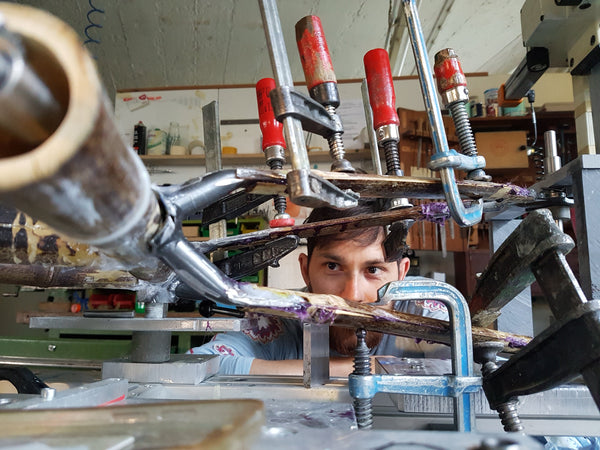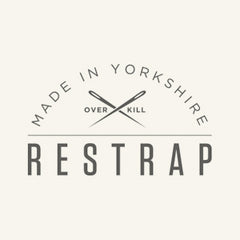Jan's Jamboo
Jun 05, 2025
Jan and I have known each other for years, and when I think back to how we met, it's quite a strange story.
We both live in a small town in Italy, and our children went to the same kindergarten. At one point, I heard this guy speaking German to his son. On top of that, he was riding a strange bamboo bike, pulling a Croozer trailer that always had a different child in it.
I thought to myself: Another one who just stayed here instead of returning to some gray city after his vacation.
At the time, I had just moved from Vienna to Italy, and I missed the Viennese charm. To put it bluntly: I may not be Viennese, but it was still better than nothing. And since I'd always been interested in these bamboo bikes anyway, I quickly got talking to him. He said he built these bikes in Germany because he worked as a model maker in a large workshop there, and I should come by his house in Italy, where he had some of these bikes.
From curiosity to collaboration
Jan and I met more and more often—at his place or on joint rides—and eventually we came up with the idea of giving him a logo and a name for his bikes. Eventually, he was trying to market the bikes better. We came up with the name "Jamboo" and created a logo for it. From the very beginning, I had some problem with the look of the bikes that I couldn't articulate. Jan wanted to sell them, and to do that, they had to be different from other bamboo bikes and, in my opinion, move away from the sandal-wearing eco-friendly image.

 Eventually, I had this vision of dyed bamboo, and we experimented for weeks to find some way to dye the bamboo away from its eco-friendly touch. He also insisted that his bikes were better than any other bamboo bike—and it showed.
Eventually, I had this vision of dyed bamboo, and we experimented for weeks to find some way to dye the bamboo away from its eco-friendly touch. He also insisted that his bikes were better than any other bamboo bike—and it showed.
 One of the first tests to dye bamboo
One of the first tests to dye bamboo
A hype – then came the standstill
Everything was going well: The colorful bikes were becoming increasingly well-known in the city, shops wanted to display them in their windows, and the first ones were selling. And then the pandemic hit and turned everything upside down within a few weeks. The entire bicycle industry faced an unprecedented parts shortage, eBay was sold out, and parts became increasingly difficult to source. Ultimately, the entire market came to a standstill because there were no more parts available.
During this time, Jan kept sending me photos and videos from his garage in Italy, which he had converted into his workshop. He had built his own tools to manufacture the frames. Once the worst was over, he suddenly showed up with a gravel bike made of bamboo: disc brakes, SRAM drivetrain, and a new frame geometry I'd never seen before. The bike looked incredible. I had been cycling a lot myself during this time because it was the only way to exercise. And when we went on our first ride, I simply couldn't keep up with him anymore—especially in the forest, my bike at the time was simply far inferior.

Once the pandemic was finally over, we finally went out and tested the bikes extensively. We needed to understand where—and if—there were any weak points in their construction. Initially, we were concerned about whether the bikes would survive the trails in the woods. We worked our way up from gravel roads to smooth flow trails to rocky mountain bike descents. Even small mountain bike jumps were no problem. We took them to the seaside and rode them through the mountains, and finally, we decided to put them through the ultimate endurance test.

Endurance test: 500 kilometers through Tuscany
Bikepacking was already a trend in Italy before the pandemic, but afterward, the gravel hype really exploded. When we competed in the Tuscany Trail in Tuscany in 2023, there were more than 4,000 participants – Jan with his pandemic gravel bike and me with the successor model, which was finished at the last minute. We made a promise to each other that this time we wouldn't take the bikes easy and would ride them as if they hadn't been handcrafted in hundreds of hours.

To this day, it's hard for me to put it into context because we rode a lot during that time, but there was hardly anyone who could keep up with us. Jan was a force on the climbs, and for me, it was more the descents than the climbs that made my bike so special. No one could keep up with me, and I sometimes overtook 20-30 people on a single descent. I've never ridden a gravel bike that could take so much punishment, had so much suspension, and remained so responsive at the same time. Both bikes lasted the entire 500 kilometers without any problems and are still ridden almost daily.

Masterpieces, no compromises
Jan's bamboo bikes have reached a level of perfection in recent years that can no longer be put into words—you just have to try it. When a person reaches a certain level of professionalism, they are called a master—and I would describe Jan's bikes as masterpieces that can no longer be compared to other bamboo bikes, but rather are on par with high-priced carbon gravel bikes.

Custom work with waiting time
Today, he builds road, endurance, and gravel bikes to order. The bikes are made of aluminum, carbon, and bamboo, and he decides which construction and geometry is right for each individual. Customers wait up to 6–12 months for him to spend hours crafting frames by hand. A bike takes over 300 hours from conception to delivery—and to date, more than 25 models have been created.

Link: Jamboo Instagram














